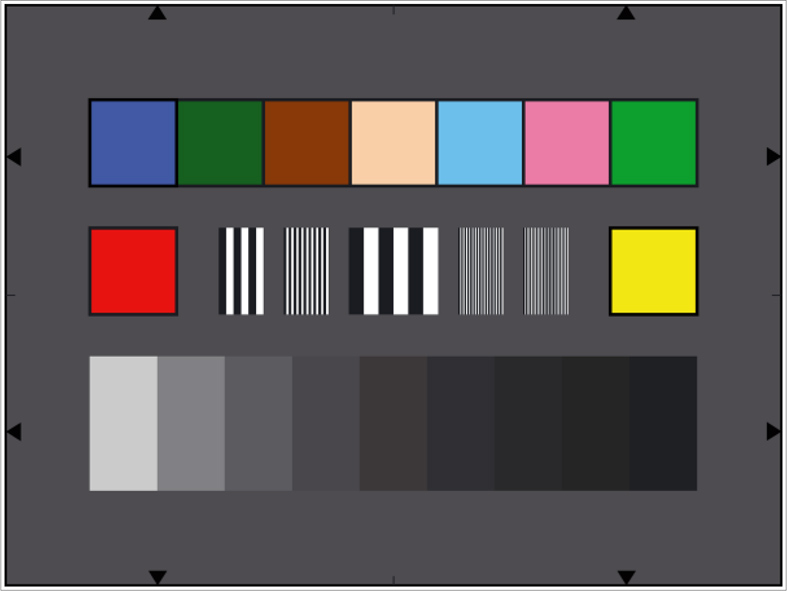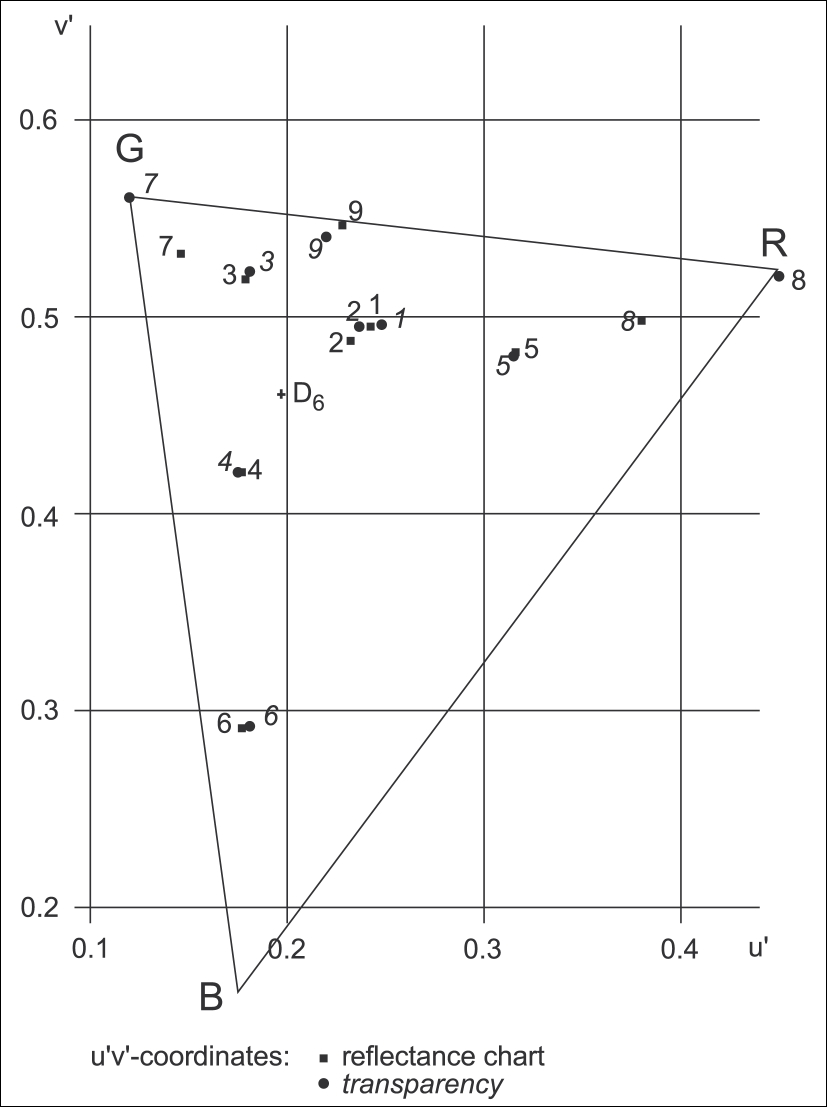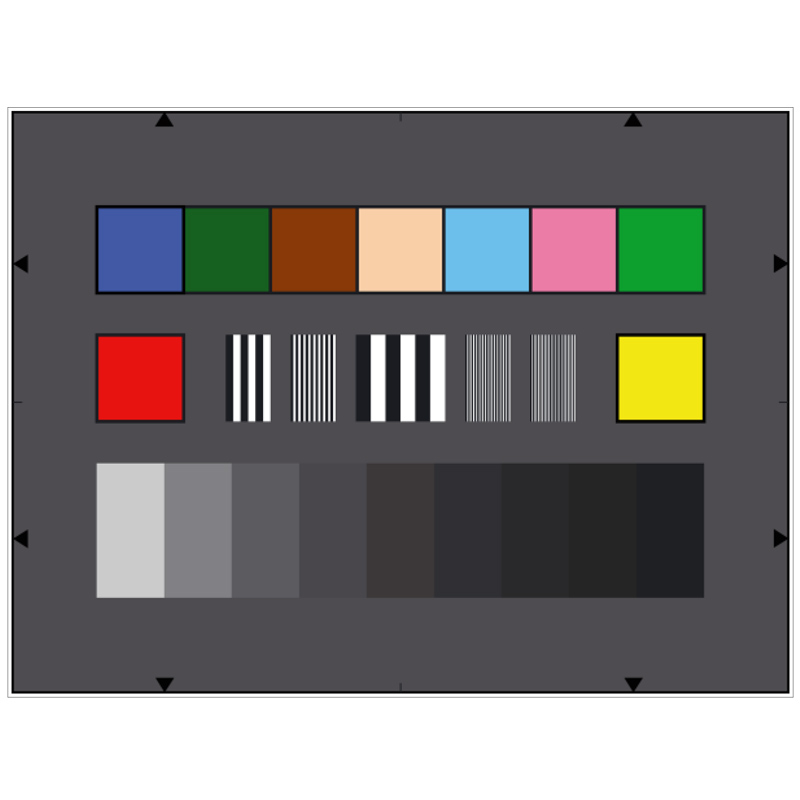-
Hotline0086-755-27198826-601
- emai:y@3nh.com
- add:F/6, Block 5B, Skyworth Inno Valley, Tangtou 1st Road, Shiyan, Baoan District, Shenzhen, P.R. China.
EBU Universal Film Test Chart Y013
- Product Introduction (in accordance with E.B.U. Document Tech. 3087 , 2ndedition) Checking color and neutral gray reproduction, relative modulation depth, gradation and granularity of film material for television. Data On a neutral gray bac
-
Product details
-
Parameters

Product Introduction
(in accordance with E.B.U. Document Tech. 3087 , 2nd edition)
Checking color and neutral gray reproduction, relative modulation depth, gradation and granularity of film material for television.
Data
On a neutral gray background with a density of D=0.75 three groups of test components are arranged within the picture-relevant area. These are:
• Nine test colors, which are selection of those contained in the Macbeth Color Rendition Chart “ColorChecker”, are arranged in the upper area of the test chart:
v4 saturated primary colors (blue, green, red and yellow) and 5 familiar colors of particular importance with a spectral reflectance which represent the average of dark and light skin-tone, foliage, blue sky and moderate red. The diagram on page 3 shows the coordinates of the colors 1 to 9 with light D65 in the u'v'color diagram of 1976. The table on page 4 indicates the names of the test colors and their respective Munsell notation.
• In the center area groups of vertical black and white bars with varying spatial distribution are arranged. They correspond to the following frequencies (from left to right): 1, 3, 0.5, 5 and 7 MHz.*
• In the lower area a 9-step neutral gray scale is located with densities varying from D=0.2 (60% reflectance white ) to D= 1.8 (1.5% reflectance, black) by equal density increases of ∆D = 0.2 from left to right. With a uniform illumination the resultant contrast range of the gray scale is thus 40:1.
Utilization
The universal film test chart was designed mainly for comparison and appraisal of films under operational conditions. It enables measurements of the most important characteristics of film materials especially intended for color television (as are density, granularity, resolution and color rendition).
Measurement evaluations of the multiple quality parameters are effected - after filming the test chart on the film material to test and after correct processing - with the film measuring device (as specified e.g. in the “Technical specifications no 12/10”). The gray scale serves for determining the gradation of the characteristic curve of the film, neutral gray rendition and granularity. The groups of vertical lines allow an assessment of the frequency response of the modulation depth. Here the reference value is the modulation depth of the 0.5 MHz raster. The test colors are used for checking the color rendition characteristics of the film material.
Furthermore the test chart can be used for matching film scanners. For this purpose the test chart has to be filmed on the film material in use. After film processing this representative color picture has to be spliced into the tape leader. This mainly facilitates the matching procedure of several scanners running simultaneously. (s. “Technical specifications... no. 12/7”, pictures 148/149).
In addition the universal film test chart allows rapid visual appraisal of the color rendition characteristics of electronic color television cameras.
Important
The reflectance chart should be lighted from both sides at an angle of 45°in order to minimize glossy effects. To delay the inevitable fading of the colors ultra- violet rays should be kept off and the test chart should be covered after use.

*Frequency data refer to the 625-line television standard
Colormetric data T 13 – transparency
Standard illuminant D 65
| B% | 14,6 | 45,2 | 0,1 | 59,5 | 37,0 | 83,4 | 5,0 | 1,3 | 0,0 |
| G% | 23,5 | 51,5 | 37,8 | 44,8 | 33,3 | 0,0 | 56,3 | 7,4 | 71,2 |
| R% | 37,4 | 73,1 | 15,0 | 30,4 | 74,8 | 22,6 | 0,0 | 63,5 | 81,9 |
| P° | 122,2 | 113,1 | 217,9 | 309,6 | 99,4 | 9,5 | 244,4 | 107,3 | 157,3 |
| FA% | 22,2 | 30,2 | 33,3 | 26,8 | 50,8 | 67,1 | 65,0 | 73,1 | 70,6 |
| V% | 9,4 | 13,9 | -10,2 | -10,3 | 25,00 | 5,6 | -29,5 | 35,1 | 13,7 |
| U% | -5,9 | -5,9 | -13,1 | 8,5 | -4,1 | 33,1 | -14,1 | -10,9 | -32,7 |
| Y% | 26,6 | 57,2 | 26,7 | 42,1 | 46,2 | 16,3 | 33,6 | 23,5 | 66,3 |
| R-Y | 0,11 | 0,16 | -0,12 | -0,12 | 0,29 | -0,06 | -0,34 | 0,40 | 0,16 |
| B-Y | -0,12 | -0,12 | -0,27 | 0,17 | -0,08 | 0,67 | -0,29 | -0,22 | -0,66 |
| Y | 0,38 | 0,35 | 0,57 | 0,26 | 0,32 | 0,05 | 0,59 | 0,34 | 0,51 |
| X | 0,43 | 0,39 | 0,33 | 0,24 | 0,44 | 0,17 | 0,28 | 0,61 | 0,46 |
| V´ | 0,51 | 0,49 | 0,56 | 0,42 | 0,48 | 0,14 | 0,56 | 0,52 | 0,56 |
| U´ | 0,25 | 0,24 | 0,14 | 0,17 | 0,30 | 0,21 | 0,12 | 0,42 | 0,22 |
| Z | 0,042 | 0,240 | 0,020 | 0,362 | 0,170 | 0,647 | 0,050 | 0,015 | 0,030 |
| Y | 0,083 | 0,320 | 0,115 | 0,195 | 0,220 | 0,043 | 0,223 | 0,099 | 0,500 |
| X | 0,093 | 0,360 | 0,064 | 0,178 | 0,310 | 0,141 | 0,105 | 0,180 | 0,450 |
| Color | Dark skin | Light skin | Foliage | Blue sky | Moderate red | Blue | Green | Red | Yellow |
| No. | 1 | 2 | 3 | 4 | 5 | 6 | 7 | 8 | 9 |
All values calculated from the colorimetric measurments results (CIE-XYZ values) from the EBU matrix
The brightness is related to the picture white (100% transmission










